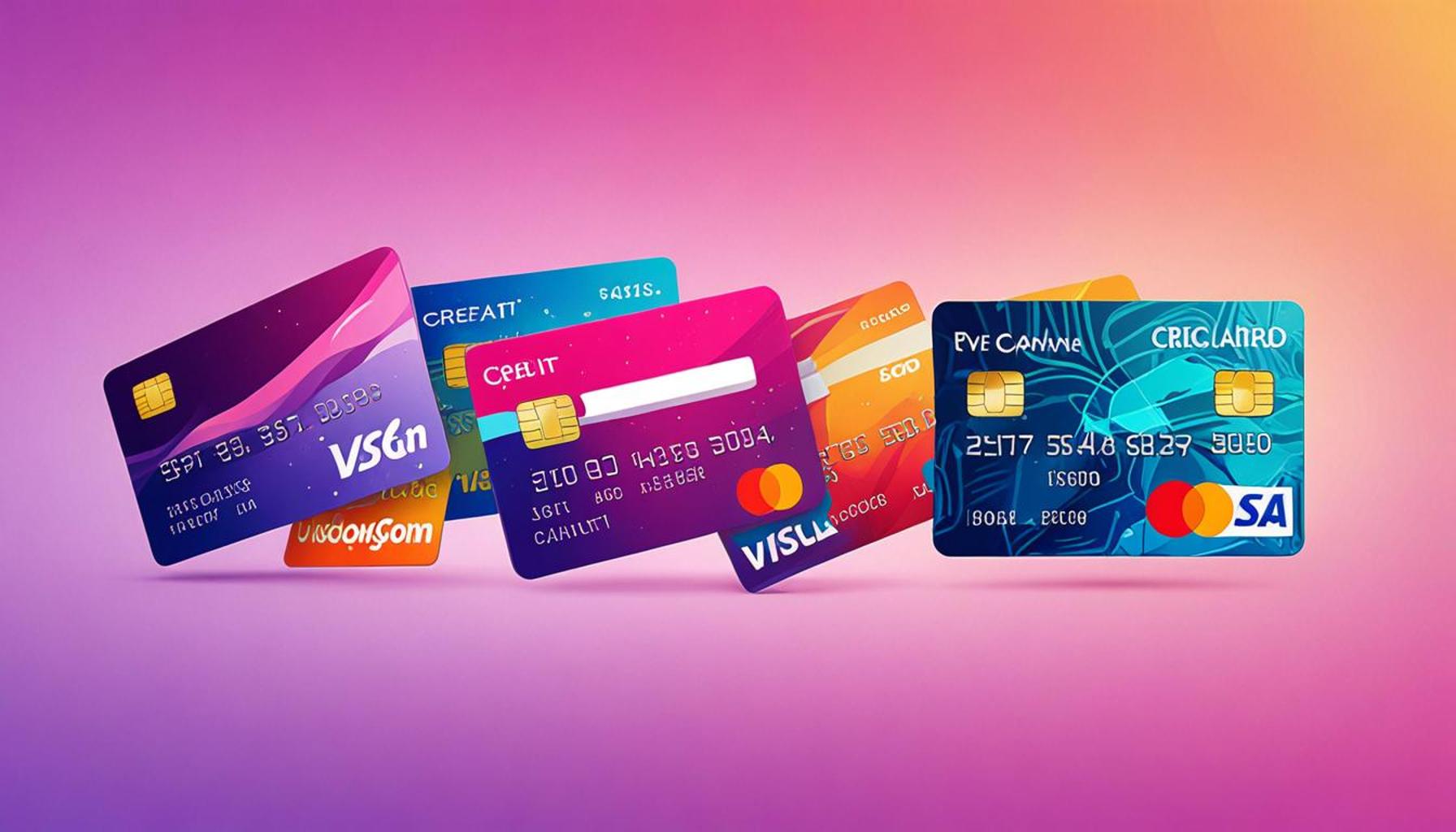The Evolution of Digital and Virtual Credit Cards

Understanding the Evolution of Payment Methods
The landscape of payment methods has undergone significant changes over the past few decades. From traditional cash transactions to the rise of digital and virtual credit cards, this evolution has been primarily driven by advancements in technology and shifts in consumer expectations. Consumers today demand both convenience and security in their financial transactions, prompting a series of remarkable innovations that make payment processes more efficient.
A prominent feature of these innovations is instant issuance. Unlike the lengthy approval processes associated with traditional physical cards, users can often obtain a digital card within minutes. This feature is particularly advantageous for individuals needing immediate access to funds, such as those traveling abroad or making urgent online purchases.
Another crucial aspect is enhanced security. Virtual cards typically generate a temporary number for each transaction, which adds an extra layer of protection against fraud. For instance, if a virtual card number is compromised, the customer can simply generate a new number, thereby mitigating the risks associated with identity theft that can occur with traditional credit cards.
The ability to track spending easily is also a significant benefit. Transactions can be monitored in real-time through dedicated apps, enabling consumers to gain insights into their spending habits. This feature encourages responsible budgeting, as individuals can set limits and receive notifications when they approach their spending thresholds.
Impact on Australian Consumers
In Australia, the adoption of digital and virtual credit cards has transformed financial management for many individuals. Major banks such as the Commonwealth Bank and NAB have embraced this trend and now offer the seamless integration of digital cards into mobile wallets like Apple Pay and Google Pay. This integration not only streamlines the payment process but also enhances security features inherent to these platforms, such as biometric authentication.
Moreover, Australian consumers are increasingly opting for online shopping, which underscores the need for secure and efficient payment options. The convenience of digital and virtual credit cards allows Australians to shop online confidently, knowing they are protected against potential fraud and can easily track their expenditure.
As we move forward, it’s vital to recognize the broader implications of these changes in the financial landscape. The introduction of digital payment methods has not only revolutionized how Australians manage their finances but also provided a more secure and user-friendly environment for financial transactions. Understanding these advancements is essential for consumers to make informed decisions about their financial tools.
Revolutionizing Payment Transactions
Digital and virtual credit cards represent a significant leap in the evolution of payment methods, catering to the modern consumer’s needs for both speed and security. Unlike traditional credit cards that rely on a physical card, digital and virtual cards exist only in electronic form and can be used for online transactions or stored in digital wallets. This change reflects a growing trend of moving away from cash and plastic towards a more streamlined, technology-driven approach to payments.
The concept of digital credit cards began gaining traction as e-commerce surged in popularity. Consumers wanted an efficient way to manage their purchases without the hassle of carrying physical cards. This need led to the development of virtual credit cards, which allow users to create temporary card numbers for specific transactions or timeframes. This is particularly useful for online shopping, where concerns about security are critical.
The rise of mobile payment platforms has also played a pivotal role in the popularity of digital and virtual credit cards. With services like Apple Pay, Google Pay, and various banking apps, consumers can now store their digital cards directly on their smartphones. This integration means that when making purchases, customers can pay swiftly with just a tap, eliminating the need to fumble through wallets or bags for a physical card. The benefits of using digital and virtual cards extend beyond convenience, encompassing:
- Instant access: Users can create and begin using virtual cards often within minutes of signing up.
- Real-time spending insights: Users can track their transactions through banking apps, providing clarity on spending habits.
- Customizable limits: Virtual cards often allow users to set spending limits, enabling better budgeting.
Another major advantage of these cards is how they handle international transactions. For Australians traveling overseas, digital and virtual cards can be particularly beneficial. Users can spend in foreign currencies without incurring hefty international transaction fees typically associated with traditional credit cards. Additionally, because virtual cards generate unique numbers for each transaction, travelers can rest easy knowing that their financial information remains secure, even in unfamiliar environments.
The security features associated with digital and virtual credit cards also merit attention. Most digital cards incorporate advanced encryption technology and tagging systems to help protect against unauthorized access. When making online purchases, the use of temporary numbers means that even if a card number is exposed, it cannot be reused for future transactions, greatly reducing the risk of fraud and identity theft.
As more consumers embrace these innovative payment options, it is essential for users to understand how to maximize their benefits. From taking advantage of enhanced security features to actively monitoring spending, Australians are well-positioned to leverage the advantages that digital and virtual credit cards provide in today’s fast-paced economy.
Enhancing User Experience and Encouraging Adoption
The evolution from traditional to digital and virtual credit cards is not solely about technological advancements; it is also about enhancing user experience. The convenience of being able to make purchases quickly and securely has encouraged many Australian consumers to adopt these innovative payment solutions. In a country where the cost of living is high and time is often of the essence, these digital tools facilitate smarter spending without compromising on security.
One of the most significant elements of this shift is the integration of loyalty programs and rewards with digital credit cards. Many financial institutions have recognized that consumers appreciate rewards for their spending habits. As a result, several digital wallets and banking apps now allow users to link their loyalty programs directly to their virtual cards. This means that for every purchase made, users can easily earn points or cash back without any extra effort. For instance, some programs reward customers with discounts at popular Australian retailers when using their digital cards.
Furthermore, the introduction of contactless payment options has accelerated the usage of digital credit cards, especially during the COVID-19 pandemic. The emphasis on hygiene and social distancing has led consumers to prefer contactless payments over cash or traditional card swipes. The ability to pay simply by tapping one’s phone or smartwatch at a terminal has become more than just a trend; it has become a norm. Studies show that more Australians are opting for contactless payments, with a growing preference evident in both urban and rural areas.
As digital and virtual cards become more mainstream, the banking sector is also adapting to these trends. Major banks in Australia have begun investing heavily in the development of digital banking services. This includes enhanced apps that provide seamless integration of banking functions and payment solutions. By offering in-app features like budgeting tools and expenditure tracking, banks empower users to take control of their financial health. This is particularly beneficial for younger generations, who are tech-savvy and prioritise convenience in their financial management.
The introduction of digital cards has also transformed business transactions. Small-to-medium enterprises (SMEs) in Australia are increasingly adopting virtual credit cards to streamline their purchasing processes. By issuing virtual cards to employees, businesses can set spending limits and monitor transactions in real-time, creating greater transparency and control over company expenses. This not only simplifies administrative processes but also helps in preventing unauthorized spending.
Moreover, as consumer technology continues to advance, the features associated with digital and virtual credit cards are expected to evolve further. Artificial intelligence and machine learning technologies are being integrated into banking systems, allowing for personalized spending insights and tailored rewards. These innovations can enhance user experience by recommending optimal spending patterns and identifying potential savings based on individual habits.
It is clear that the journey of digital and virtual credit cards is not just about offering a convenient method of payment. Rather, it’s about reshaping how Australians interact with their finances and embrace modern payment solutions. As these trends continue to unfold, consumers can anticipate a world where banking services are not just digitised but enhanced through innovative features designed with user experience at the forefront.
Conclusion
The journey of digital and virtual credit cards illustrates a remarkable shift in how Australians manage their financial transactions. As consumers continue to embrace these innovative payment methods, it is clear that the benefits extend beyond mere convenience. The integration of loyalty programs and the rise of contactless payment options have not only boosted user engagement but have also transformed everyday purchasing experiences into opportunities for rewards and savings.
Moreover, the financial landscape in Australia is evolving dramatically as banks and financial institutions recognize the need for advanced digital solutions. The incorporation of features such as budgeting tools and expenditure tracking in mobile banking apps empowers consumers to take greater control of their finances. This is particularly valuable in today’s fast-paced environment, where managing spending effectively is essential.
The evolution of digital payment solutions also provides SMEs with the tools to streamline their purchasing processes, enhancing both transparency and operational efficiency. As artificial intelligence and machine learning continue to play a pivotal role in shaping consumer experiences, we can expect increasingly tailored services that cater to individual spending habits.
Ultimately, as Australia continues to expand its use of digital and virtual credit cards, consumers are not just witnessing a shift in technology but are also experiencing a revolution in financial management. The future holds promising developments, and as these technologies grow more sophisticated, they will continue to redefine the way Australians interact with their finances, paving the way for smarter and more rewarding spending habits.

Linda Carter is a writer and financial expert specializing in personal finance and financial planning. With extensive experience helping individuals achieve financial stability and make informed decisions, Linda shares her knowledge on the Take Care Garden platform. Her goal is to empower readers with practical advice and strategies for financial success.





